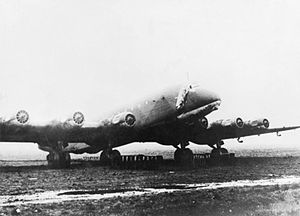Junkers Ju 390
The Ju 390 from Junkers Flugzeug- und Motorenwerke in Dessau was an enlarged further development of the four-engine Ju 290 . The design comes from Junkers chief designer Ernst Zindel . The Ju 390 was equipped with six engines, otherwise it corresponded to its predecessor model (except for the dimensions and the range ).
description
A prototype of the Ju 390 was only built in 1943 in the Junkers factory in Merseburg , for which the fuselage of the Ju 90 V6 was used. The machine was lengthened and got completely new wings, eight meters longer with now six engines and four main landing gears. In addition, instead of the oval, the machine received the new and larger trapezoidal vertical stabilizers. The machine also had a transport hatch on the underside of the fuselage stern.
The aircraft called Ju 390 V1 with the registration number GH + UK made its maiden flight from Merseburg on October 20, 1943 . It was equipped as a transporter without on-board weapons and was also tested as a sea reconnaissance aircraft. The extensive flight tests were carried out at the Rechlin test center and in Prague . There it was also successfully tested in the test program for air refueling of the German Research Institute for Glider Flight (DFS).
In November 1944 the machine was moved to the Junkers works airfield in Dessau . It was shut down there and all propellers removed. In April 1945 the machine was set on fire by Junkers factory employees because it was not supposed to fall into the hands of the Allies .
A second machine (it was started as a completely new build) was the Ju 390 V2. It was under construction in Merseburg (according to other information in Dessau), but was not completed until the end of the war. The flight log of Lieutenant Eisermann from the Rechlin test site, however, shows that he transferred the Ju 390 V2 on February 3, 1945 from Rechlin to Lärz .
Alleged real photos of the Ju 390 V2 in flight with the trunk number RC + DA are proven photomontages .
Planned versions of the Junkers Ju 390 were:
- Ju 390 A: Transporter
- Ju 390 B: Sea and long-range reconnaissance aircraft
- Ju 390 C: long-range bomber
- and for the time after Hitler's " final victory " a civil version as the Ju 390 D was also planned. Junkers diesel engines were also considered as a drive for this. However, as early as 1940 Junkers had projects for a six-engine civil aircraft for Lufthansa , including the EF 100 design .
In the years 1941 to 1943 Junkers had, in addition to the above-mentioned design for the six-engine Ju 290/6 engine (the later Ju 390), two designs for an eight-engine variant of the Junkers Ju 290, namely the twin Ju 290Z and the single- hull version Ju 290 / 8mot (unofficially Ju 490). The corresponding type designations Ju 290Z and Ju 490 were not assigned by the Reich Aviation Ministry for these projects .
Technical specifications
| Parameter | Data |
|---|---|
| crew | 4 to 10 people |
| length | 34.20 m |
| span | 50.32 m |
| height | 6.89 m |
| Wing area | 251.6 m² |
| payload | over 10,000 kg (as a military transporter) |
| Max. Takeoff mass |
|
| Top speed |
|
| Service ceiling | 6000 m |
| Range |
|
| Maximum flight time | up to 32 hours |
| Engines | six 14- cylinder twin radial engines BMW 801 G-2 with 1700 hp each |
| Armament | up to eight 20 mm cannons and up to eight 13 mm MG-131 (Ju 390 B and C) |
literature
- Wolfgang Wagner: Hugo Junkers aviation pioneer - his aircraft. From the series: German aviation. Volume 24. Bernard & Graefe Verlag, Bonn 1996, ISBN 3-7637-6112-8 .
- Horst Lommel: From altitude reconnaissance to space glider 1935–1945. DFS secret projects. Motorbuch Verlag, Stuttgart 2000, ISBN 3-613-02072-6 .
- Heinz J. Nowarra : The German Air Armament 1933-1945. Volume 3, Bernard & Graefe Verlag, 1993, ISBN 3-7637-5464-4 (complete work), ISBN 3-7637-5467-9 (volume 3).
- Manfred Griehl: German military aircraft 1933–1945 From the series: Typenkompass Motorbuch Verlag, Stuttgart 2008, ISBN 978-3-613-02850-0
See also
Web links
Individual evidence
- ^ Heinz J. Nowarra: The German Air Armament 1933-1945. Volume 3, p. 130.


